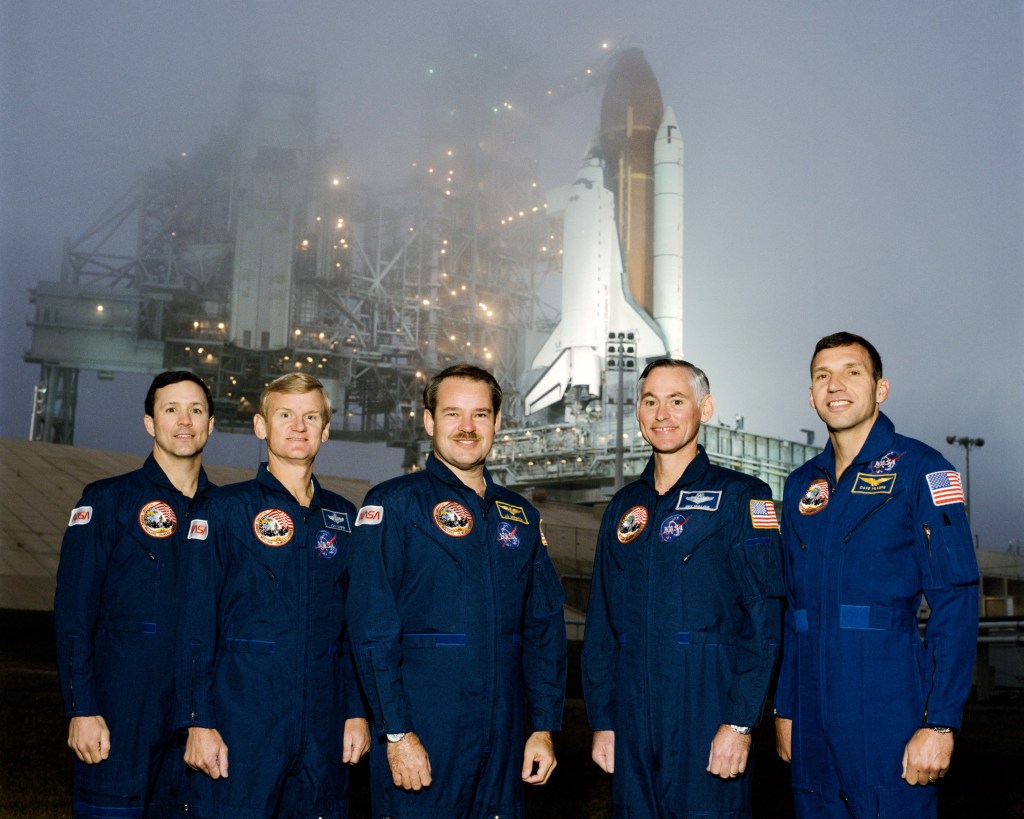On Feb. 28, 1990, space shuttle Atlantis took off from NASA’s Kennedy Space Center in Florida on STS-36, the sixth shuttle mission dedicated to the Department of Defense. As such, many of the details of the flight remain classified. The mission marked the 34th flight of the space shuttle, the sixth for Atlantis, and the fourth night launch of the program. The crew of Commander John Creighton, Pilot John Casper, Mission Specialists Mike Mullane, David Hilmers, and Pierre Thuot flew Atlantis to the highest inclination orbit of any human spaceflight to date. During the four-day mission, the astronauts deployed a classified satellite, ending with a landing at Edwards Air Force Base in California.
The STS-36 crew, from left, was Mission Specialist Pierre Thuot, left, Pilot John Casper, Commander John Creighton, and Mission Specialists Mike Mullane and David Hilmers.NASA The STS-36 crew patch. NASAIn February 1989, NASA assigned astronauts Creighton, Casper, Mullane, Hilmers, and Thuot to the STS-36 mission. The mission marked the second spaceflight for Creighton, selected as an astronaut in 1978. He previously served as the pilot on STS-51G. Mullane, also from the class of 1978, previously flew on STS-41D and STS-27, while Hilmers, from the class of 1980, previously flew on STS-51J and STS-26. For Casper and Thuot, selected as astronauts in the classes of 1984 and 1985, respectively, STS-36 marked their first trip into space.
Atlantis returned from its previous flight, STS-34, in October 1989. The orbiter spent a then-record 75 days in the processing facility and assembly building, rolling out to Launch Pad 39A on Jan. 25, 1990. The astronauts arrived on Feb. 18 for the planned launch four days later. First Creighton, then Casper and Hilmers, came down with colds, delaying the launch to Feb. 25. Weather and hardware problems pushed the launch back to Feb. 28, giving the astronauts time to return to Houston for some simulator training. On launch day, winds and rain delayed the liftoff for more than two hours before launch controllers gave Atlantis the go to launch.
Liftoff of space shuttle Atlantis on STS-36. NASAWith mere seconds remaining in the launch window, Atlantis lifted off at 2:50 a.m. EST Feb. 28, to begin the STS-36 mission. Atlantis flew an unusual dog leg maneuver during ascent to achieve the mission’s 62-degree inclination. Once Atlantis reached orbit, the classified nature prevented any more detailed public coverage of the mission. The astronauts likely deployed the classified satellite on the mission’s second day. During the remainder of their mission, the astronauts conducted several experiments and photographed preselected areas and targets of opportunity on planet Earth. Their high-inclination orbit enabled them to photograph areas not usually seen by shuttle crews.
In-flight photo of the STS-36 crew on Atlantis’ flight deck.NASA STS-36 crew members David Hilmers, left, Pierre Thuot, and John Casper work in the shuttle’s middeck. NASA Mission Specialist Mike Mullane takes photographs from Atlantis’ flight deck.NASA A selection of crew Earth observation photographs from STS-36. The coast of Greenland.NASA New York City at night.NASA The Nile River including Cairo and the Giza pyramidsNASA The coast of Antarctica. NASA John Creighton prepares drink bags for prelanding hydration. NASA Atlantis touches down at Edwards Air Force Base in California. NASA NASA officials greet the STS-36 astronauts as they exit Atlantis.NASATo maintain the mission’s confidentiality, NASA could reveal the touchdown time only 24 hours prior to the event. On March 4, Creighton and Casper brought Atlantis to a smooth landing at Edwards Air Force Base after 72 orbits of the Earth and a flight of four days, 10 hours, and 18 minutes. About an hour after touchdown, the astronaut crew exited Atlantis for the ride to crew quarters and the flight back to Houston. Later in the day, ground crews prepared Atlantis for the ferry ride back to Kennedy. Atlantis left Edwards on March 10 and three days later arrived at Kennedy, where workers began to prepare it for its next flight, STS-38 in November 1990.
Explore More
14 min read40 Years Ago: STS-4, Columbia’s Final Orbital Flight Test
Article 3 years ago 6 min read40 Years Ago: STS-51C, the First Dedicated Department of Defense Shuttle Mission
Article 1 month ago 18 min read40 Years Ago: NASA Selects its 10th Group of Astronauts
Article 9 months ago Read More Details
Finally We wish PressBee provided you with enough information of ( 35 Years Ago: STS-36 Flies a Dedicated Department of Defense Mission )
Also on site :
- Watch Live: American Cardinal Robert Provost chosen as new pope
- Former Pomona police officers acquitted in brutality case settle lawsuit against city for $2.5 million
- White smoke appears over Sistine Chapel as Conclave elects new Pope

